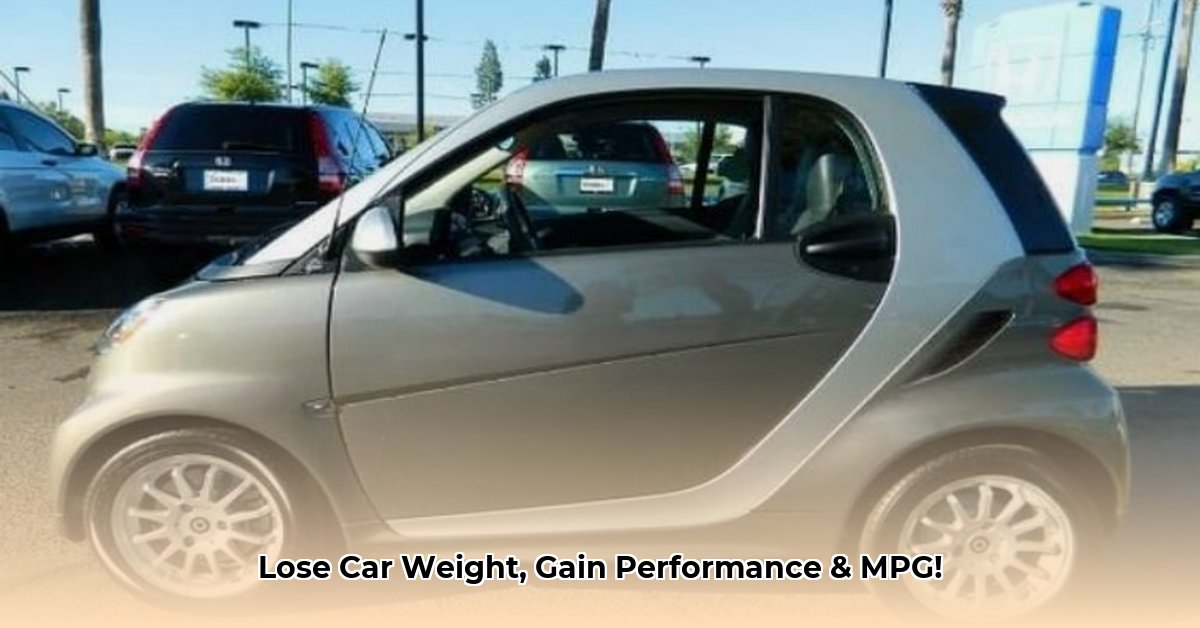
Want a faster, more fuel-efficient car without breaking the bank? Shedding excess weight is the key. A lighter car accelerates quicker, handles better, and boasts improved gas mileage. This guide provides a step-by-step approach to safely and effectively reduce your car's weight, categorized by risk level and stakeholder involvement.
Easy Weight Savings: DIY Projects (Low Risk)
These simple, inexpensive modifications are perfect for beginners. Even small changes can make a noticeable difference. How much weight can you realistically save? A surprising amount!
Purge the Unnecessary (Estimated Weight Savings: 20-50 lbs): Remove anything you don't regularly need. This includes spare tires (unless legally required), jack, tool kit, and any unnecessary cargo. Even removing infrequently used back seats can significantly lighten the load.
Roll with Lighter Wheels and Tires (Estimated Weight Savings: 10-30 lbs per wheel): Upgrading to lighter alloy wheels reduces "unsprung mass" (the weight of components that aren't supported by the suspension), improving handling and acceleration. Combine this with lighter-weight tires for maximum impact. Always check your vehicle's specifications to ensure compatibility.
Trunk Tidy-Up (Estimated Weight Savings: Variable): Regularly clear out your trunk. Unnecessary items add up quickly. This is an ongoing process, but the benefits of consistent decluttering are significant. Think of it as regular car maintenance. Do you regularly carry over 50 lbs of unnecessary items in your vehicle?
Moderate Weight Reduction: More Involved (Medium Risk)
These modifications offer greater weight savings but require some mechanical knowledge or professional assistance. Remember to always prioritize safety.
Lightweight Battery Power-Up (Estimated Weight Savings: 10-25 lbs): Replacing your lead-acid battery with a lighter lithium-ion battery can significantly reduce weight. However, proper installation is crucial. Improper installation can cause electrical issues. Consult a qualified mechanic or battery specialist to ensure compatibility and correct installation.
Aftermarket Upgrades (Estimated Weight Savings: Variable): Explore lighter-weight replacement parts like aluminum or carbon fiber components for the engine bay, brakes, or suspension. Note: Not all aftermarket parts are created equal, and proper fitment is crucial. Research reputable manufacturers and consult with a mechanic before installation.
Interior Makeover (Lightweight) (Estimated Weight Savings: 10-30 lbs): Replace heavy carpeting and sound-deadening materials with lighter alternatives. This may compromise sound insulation and comfort. Carefully consider if the weight savings are worth the trade-off.
Advanced Weight Reduction: Serious Investment, Serious Results (High Risk)
These methods provide substantial weight savings but require significant investment and professional installation to ensure safety and structural integrity.
Body Panel Swap (Estimated Weight Savings: 50-150 lbs): Replacing heavy steel body panels (hood, doors, trunk lid) with lighter fiberglass or carbon fiber composites drastically reduces weight. This is a complex process requiring expertise to maintain structural integrity and safety. This modification should only be undertaken by experienced professionals.
Engine Component Swap (Estimated Weight Savings: Variable): Swapping heavy engine components (like cast iron parts) for aluminum or titanium alternatives can significantly reduce weight and boost performance. This requires extensive mechanical knowledge and precision. Incorrect installation can cause catastrophic engine damage, so leave this to experienced professionals.
Weight Reduction Risk Assessment Matrix
Understanding the risks associated with different modifications is crucial. The following matrix categorizes components by risk level:
| Component | High Risk (Safety Critical) | Medium Risk (Performance Impact) | Low Risk (Cosmetic/Convenience) |
|---|---|---|---|
| Engine Components | Engine block, crankshaft, connecting rods | Cylinder heads, intake manifold | Pulleys, belts |
| Brakes | Brake calipers, master cylinder, brake lines | Brake rotors, brake pads | |
| Wheels & Tires | N/A | Wheel material, tire type | Tire pressure |
| Body Panels | N/A | Hood, doors, fenders, roof (affects structural integrity) | Bumpers, trim panels |
| Windows | Windshield (critical for structural integrity) | Side/Rear Windows | |
| Interior Components | Seatbelts, airbags | Seats (consider structural bracing impact) | Carpeting, trim, sound deadening materials |
Before undertaking any modifications, consult a qualified mechanic to ensure safety and legal compliance.
How to Legally Reduce Car Weight for Improved Performance: A Step-by-Step Guide
Remember, safety and legality are paramount. Improper modifications can void warranties and compromise safety.
Step 1: Declutter and Assess. Begin by removing unnecessary items. Every pound counts. Evaluate items you regularly carry and consider lighter alternatives.
Step 2: Targeted Component Upgrades. Focus on easily accessible upgrades like lighter wheels and tires. Always check for compatibility and adhere to load rating requirements.
Step 3: Professional Consultation (for advanced modifications). For complex modifications like body panel or engine component swaps, seek professional expertise to ensure safety and compliance.
Step 4: Compliance and Verification. Make sure all modifications comply with local laws and regulations. Obtain necessary certifications or approvals if required.
Key Takeaways:
- Removing unnecessary items provides immediate, low-risk weight savings.
- Upgrading to lightweight materials offers significant long-term benefits but requires careful planning.
- Always prioritize safety and legal compliance. Improper modifications can be extremely dangerous.
- A balanced approach considers performance, cost, and environmental impact. A lighter vehicle is not inherently better; ensure all modifications are carefully considered and safely implemented.